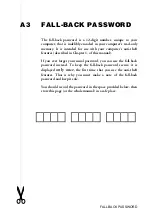
A n t i - s t a t i c p r e c a u t i o n s
1
A1
ANTI-STATIC
PRECAUTIONS
Static electricity can cause permanent damage to electronic
components. You should be aware of this risk, and take precautions
against the discharge of static electricity into the computer.
Static electricity can be generated by moving on a chair, brushing
against desks or walls, or simply walking across an ordinary carpet.
Items handed from one person to another, or being wrapped or
unwrapped, can acquire a static charge. Air conditioning systems
can also result in very high levels of static.
Clothing made of synthetic fibres is particularly likely to generate
static electricity. This static electricity is often completely unnoticed
by the wearer, but can be sufficient to cripple or destroy sensitive
electronic components in computers.
The computer is at risk from static discharge while the top cover is
off, as the electronic components of the motherboard are exposed.
Memory modules, cache upgrades and OverDrive processors are
other examples of electrostatic sensitive devices (ESSDs).
All work that involves removing the cover must be done in an area
completely free of static electricity. We recommend using a Special
Handling Area (SHA) as defined by EN 100015-1: 1992. This
means that working surfaces, floor coverings and chairs must be
connected to a common earth reference point, and you should wear
an earthed wrist strap and anti-static clothing.
It is also a good idea to use an ionizer or humidifier to remove static
from the air.
♦
When installing any upgrade, be sure you understand what the
installation procedure involves before you start. This will
enable you to plan your work, and so minimise the amount of
time that sensitive components are exposed.
♦
Do not remove the system unit cover, nor the anti-static bag or
wrapping of any upgrade, until you need to.







































